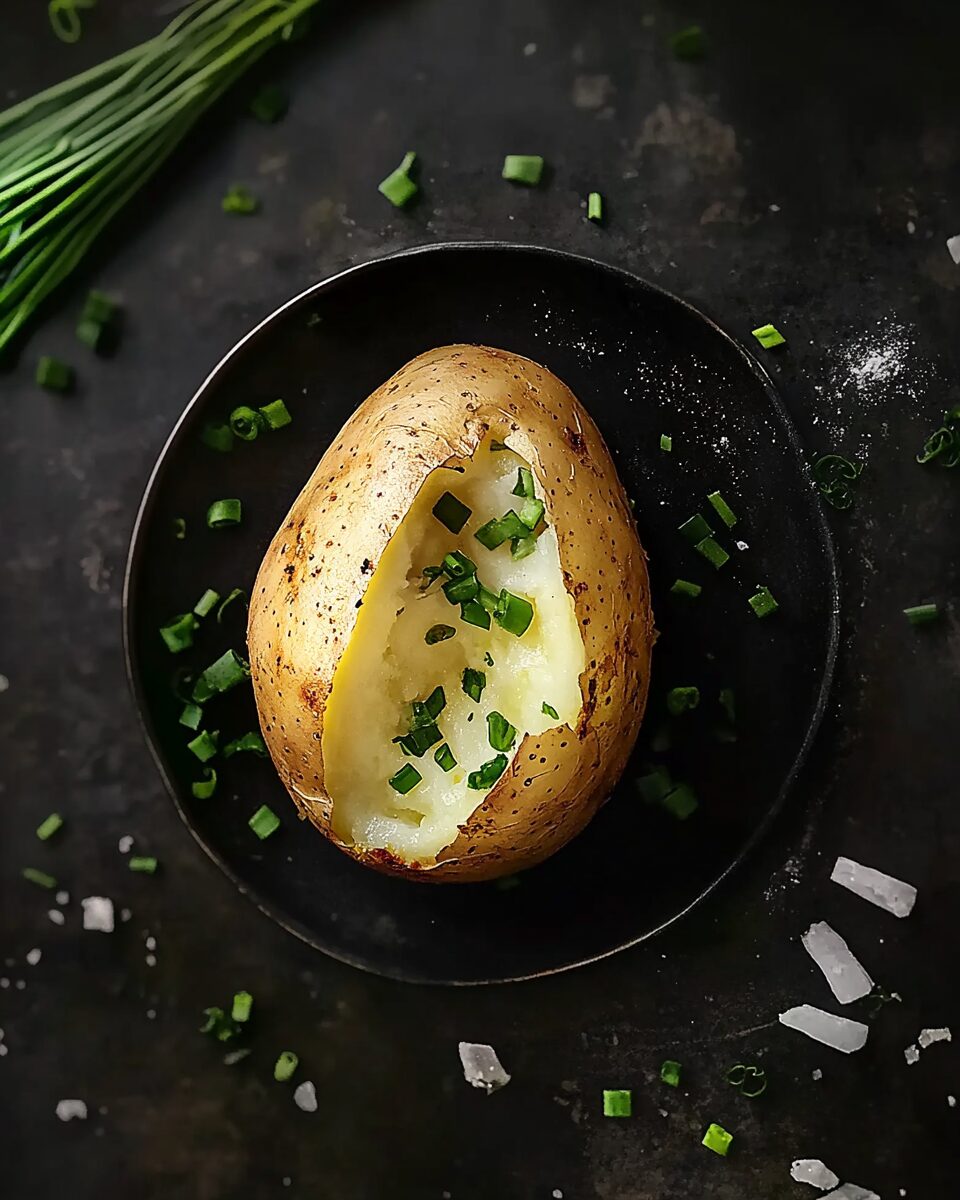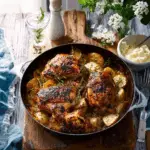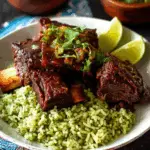The Classic Baked Potato is a timeless dish that delivers pure comfort in every bite. Its crisp, golden skin gives way to a tender, fluffy interior that pairs perfectly with butter, cheese, or any topping of your choice. Whether served as a side dish or a hearty meal, this baked potato is a versatile classic that never fails to satisfy.
What’s even better is the simplicity of its preparation. With just a few basic ingredients and minimal effort, you can create a dish that’s both elegant and nourishing. Perfect for a weeknight dinner, a barbecue, or even a cozy weekend treat, this baked potato is sure to become a family favorite.
Full Recipe:
- 1 medium baking potato
- 1 teaspoon olive oil
- ½ teaspoon salt
- 2 teaspoons butter
- 1 pinch freshly ground black pepper
- ¼ cup shredded Cheddar cheese
Directions:
- Preheat the oven to 300°F (150°C). Scrub the potato thoroughly and pierce the skin several times with a knife or fork.
- Rub the potato skin with olive oil, then generously coat it with salt.
- Place the potato directly on the oven rack and bake for approximately 90 minutes or until the skin is golden brown and the interior is soft.
- Remove the potato from the oven and slice it down the center. Fluff the inside with a fork.
- Add butter and black pepper to taste. Sprinkle shredded Cheddar cheese over the top for extra flavor, if desired. Serve warm.
Prep Time: 5 minutes | Cooking Time: 90 minutes | Total Time: 1 hour 35 minutes
Kcal: 419 kcal | Servings: 1 serving
The Perfect Baked Potato: A Simple and Versatile Classic
Baked potatoes are a timeless and beloved dish that has graced dinner tables for centuries. Whether as a side or the main event, the perfect baked potato has a crispy, golden skin with a fluffy interior that makes every bite a comfort. While it seems simple, achieving the perfect baked potato requires attention to detail. In this article, we’ll dive into the methods, tips, and variations that will elevate your baked potato game.
Understanding the Basics of a Perfect Baked Potato
At its core, the baked potato is a straightforward dish. It starts with a high-starch potato, often the russet, due to its thick skin and fluffy interior. This starch allows the potato to bake up to that perfect texture, with the crispiness of the skin contrasting beautifully with the soft, pillowy interior.
The method is simple: bake the potatoes in a hot oven until the skin is golden and crisp, and the inside is tender enough to be fluffed with a fork. However, to truly achieve perfection, there are a few key techniques that can elevate a humble potato into a delectable delight.
The Secret to Crispy Skin
One of the most important aspects of a baked potato is the skin. The right skin should be crisp and flavorful, providing a satisfying texture contrast to the soft insides. To achieve this, start by thoroughly scrubbing the potatoes to remove any dirt or debris. After rinsing, you should pierce the skin a few times with a fork or knife. This is essential as it allows steam to escape during the baking process, preventing the potato from bursting open.
Next, rub the potato skin with a bit of olive oil. Olive oil not only adds a rich flavor to the skin but also helps it crisp up during baking. Some people even use butter or bacon fat for a more indulgent result. After applying the oil, generously sprinkle the potatoes with salt. Salt is a must, as it enhances the flavor of the skin and contributes to the crispy texture.
Baking Temperature and Timing
Baking potatoes at the right temperature is crucial. While many recipes recommend baking at 350°F (175°C), the method for the perfect baked potato often involves a slightly lower temperature. Baking at around 300°F (150°C) allows the potatoes to cook slowly, resulting in a more tender flesh and a crispier skin. This method typically takes 90 minutes, but larger potatoes might need longer. Alternatively, you can bake at a higher temperature like 375°F (190°C), but be sure to monitor the potatoes closely to avoid over-drying the skin.
An important tip for baking potatoes is to avoid wrapping them in foil. While foil can trap moisture and create a soft, steamed skin, it doesn’t result in the crispiness most people desire. Simply place the potatoes directly on the oven rack or on a baking sheet, and let the heat do its magic.
How to Tell When a Baked Potato Is Done
While baking time is a helpful guideline, the most reliable way to determine if your baked potato is done is by checking its internal temperature. When the potato reaches 210°F (99°C), it’s perfectly cooked. You can also test it by gently squeezing the sides of the potato; if the skin gives way and the potato feels soft inside, it’s ready. If you’re unsure, a quick check with a fork can also help – it should pierce easily without resistance.
The Versatility of Toppings
One of the best things about baked potatoes is their versatility. The baked potato serves as a perfect base for a variety of toppings, allowing you to customize it to suit your tastes. The classic combination of butter, sour cream, salt, and pepper is a favorite for many, but there are endless possibilities to experiment with.
Cheese lovers will enjoy the addition of melted Cheddar cheese, while crispy bacon bits can add both texture and flavor. For a heartier option, try chili, pulled pork, or even vegetables like sautéed mushrooms or steamed broccoli. The possibilities are truly endless, and you can tailor your baked potato to match the season, your cravings, or the rest of your meal.
Serving and Storing Leftover Baked Potatoes
While freshly baked potatoes are a delight, sometimes you may have leftovers. Don’t worry – baked potatoes store well in the fridge and can be reheated without losing much of their charm. Simply place the leftover potatoes in an airtight container or wrap them in plastic wrap and refrigerate. When reheating, you can bake them again in the oven at 350°F (175°C) for about 15-20 minutes. Alternatively, microwaving them for a couple of minutes covered with a damp paper towel works too.
If you want to repurpose your leftover baked potatoes, they can be mashed, turned into potato salad, or even used to make potato skins for a fun snack.
Common Mistakes to Avoid When Baking Potatoes
Despite the simplicity of baked potatoes, there are common mistakes that can affect the outcome. Here are a few to keep in mind:
- Not Piercing the Skin: Always pierce your potato several times before baking. Failure to do so can cause the potato to explode as it bakes.
- Overcrowding the Oven: If you’re baking multiple potatoes, ensure they have enough space to bake evenly. Overcrowding can lead to uneven cooking and mushy potatoes.
- Wrapping in Foil: While foil might seem like an easy way to bake potatoes, it prevents the skin from becoming crispy. Stick to baking the potatoes uncovered for the best results.
- Using the Wrong Potato: For the perfect baked potato, it’s essential to use the right type of potato. Russet potatoes are the go-to choice for their starchy texture and thick skin.
- Not Letting the Potato Rest: After baking, let the potato rest for a few minutes before slicing it open. This ensures the interior stays fluffy and doesn’t become mushy.
Conclusion: The Timeless Appeal of the Baked Potato
The perfect baked potato is a simple yet elegant dish that can be enjoyed by all. Whether you’re preparing it for a casual weeknight dinner or a festive gathering, the versatility and ease of this dish make it a family favorite. With the right technique – from seasoning to baking – you can create a potato that has a crispy skin and a light, fluffy interior every time. Experiment with toppings and serve it as a side or make it the star of your meal.
A baked potato is more than just food; it’s an invitation to get creative in the kitchen and explore new flavors. So, whether you prefer the classic butter and sour cream or something more adventurous, there’s no wrong way to top your baked potato. The perfect baked potato will always be a comforting, satisfying treat that brings joy to any meal.






